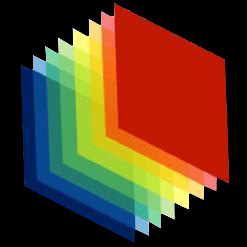
IRISPI: James Larkin (UCLA)
|
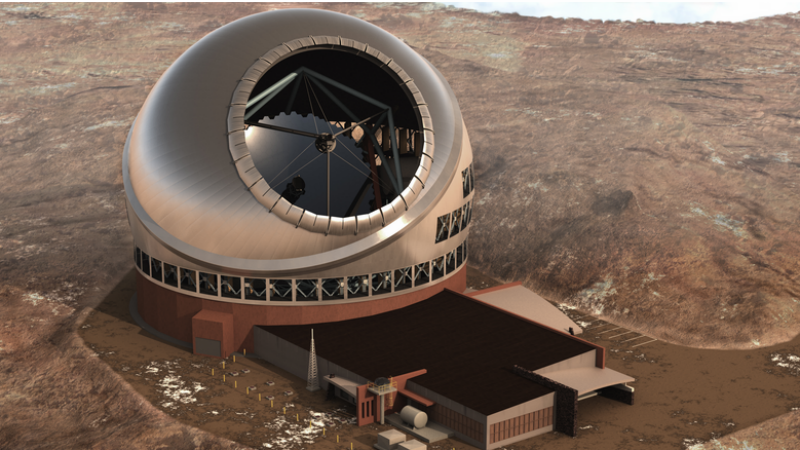 TMTFirst Light Instrument for the Thirty Meter Telescope (TMT) |
| Overview | Spectrograph | Imager | Wavefront Sensors | Atmospheric Dispersion | Science | Members |
IRIS Instrument Overview
IRIS is a first generation near-infrared (0.85-2.5 μm) instrument being designed to sample the diffraction limit of the Thirty Meter Telescope (TMT). IRIS will include an integral field spectrograph (R~4000) and imaging camera (17″x17″). Both the spectrograph and imager will take advantage of the high spatial resolution achieved with the Narrow-Field Infrared Adaptive Optics System (NFIRAOS) at four spatial scales (0.004″, 0.009″, 0.025″, 0.05″). IRIS will achieve an angular resolution ten times better than images from the Hubble Space Telescope, and will be the highest angular resolution near-infrared instrument in the world.
| Integral Field Spectrograph | |
|---|---|
| Wavelength coverage | 0.8–2.5 μm; multiple gratings (shared by lenslet and slicer) |
| Spectral Resolution | R=4000; potential R=8000 |
| Spatial Scales | Lenslet: 0.004″, 0.009″ Slicer: 0.025″, 0.05″ |
| Field Size | BB=Broadband, NB=Narrowband 4mas: 0.064"x0.512"(BB); 0.458"x0.512"(NB) 9mas: 0.144"x1.152"(BB); 1.008"x1.152"(NB) 25mas: 1.1"x2.275" 50mas: 2.2"x4.55" |
| Image Quality | Wavefront error less than 30 nm; coarser scales (25/50mas) may deviate from this |
| Filters | Broadband filters (Y, Z, J, H, K), Narrowband (5 % bandpass) filters, and specialized filters (< 1% bandpass) |
| Detector | 4096 x 4096 Teledyne Technologies Hawaii-4RG and ASIC; 15 μm pixels, long-wavelength cutoff @2.5 μm; low charge persistence; highest QE |
| Imager | |
|---|---|
| Wavelength coverage | 0.8–2.5 μm |
| Spatial Scale | 0.004″ per pixel¨ |
| Field Size | 17.2″ x 17.2″ |
| Image Quality | Wavefront error less than 30 nm |
| Astrometry | Absolute accuracy = 2 mas Relative accuracy = 30 μas |
| Filters | Broadband filters (Y, Z, J, H, K), Narrowband (5 % bandpass) filters, and specialized filters (< 1% bandpass) |
| Detector | 4096 x 4096 Teledyne Technologies Hawaii-4RG and ASIC; 15 μm pixels, long-wavelength cutoff @2.5 μm; low charge persistence; highest QE |
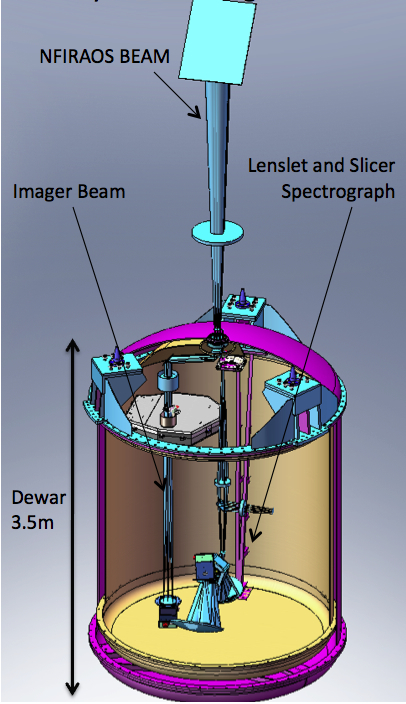
Integral Field Spectrograph
Team Leads: James Larkin (UCLA), Anna Moore (Caltech), Brian Bauman (UCSC)
The purpose of an integral field spectrograph (IFS) is to acquire spectra over a two-dimensional area of the sky, where for each spatial location (or dissecting element) a spectrum is produced. IRIS is designed with two spatial sampling techniques, lenslet array and mirror slicer, to optimize the best quality spectra with both high throughput and low wavefront error. Both the lenslet array and slicer optics are fed into a single spectrograph, and share similar optics (i.e., TMAs, reimaging optics, gratings, filters, and detector). The lenslet array is used for the finest spatial resolutions (0.004″, 0.009″) and the mirror slicer is used for the coarsest spatial resolutions (0.025″, 0.05″). When delivered, IRIS will have a fully packaged data reduction pipeline for real-time reductions during observations and final reductions for user astronomers.
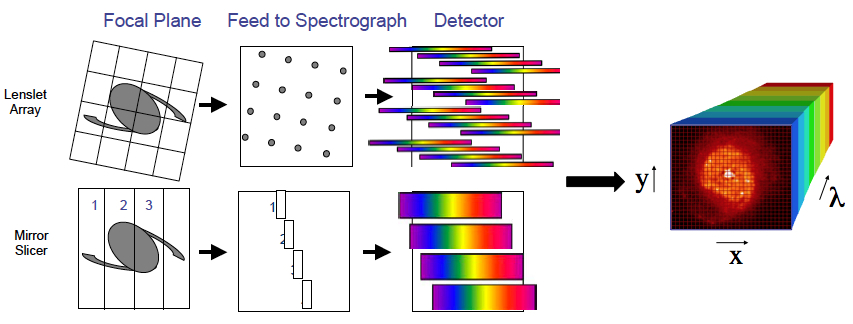 |
| Above: Cartoon illustration showing how a lenslet array (top) and slicer (bottom) samples the plane of the sky and the locations of the spectra along the 2D detector. The IRIS pipeline will then extract each spectrum from the detector and generate a reduced cube (x, y, wavelength). |
Imager
Team Leads: Ryuji Suzuki (IfA), Masahiro Konishi (NAOJ), Tomonori Usuda (NAOJ)
The near-infared (0.8 - 2.5 μm) imager will have a spatial sampling of 0.004″ per pixel with a total field of view of 17.2″ x 17.2″. The optical design has been optimized to achieve the lowest wavefront error (~30 nm) in order to sample the high spatial resolutions achieved from the adaptive optics system, NFIRAOS. The leading science cases for the imager require a high level of astrometric precision (e.g., Galactic Center, star forming regions,). The imager is expected to achieve an astrometric absolute accuracy of 2-4 mas and relative accuracy of 30 μas.
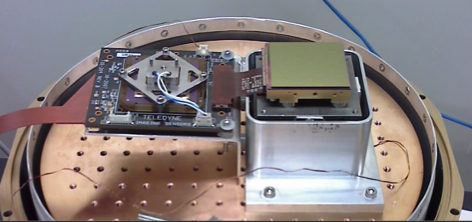 |
| Above: Picture of the latest Hawaii-2RG detector being tested at UCLA's infrared laboratory. Both the IRIS imager and spectrograph are being desiged to use the developing Teledyne Hawaii-4RG detector, which should have similar low readout and detector noise and high quantum efficiencies to the Hawaii-2RG detector. |
On-Instrument Wavefront Sensors (OIWFS)
Team Leads: David Loop (HIA) and Anna Moore(Caltech)
IRIS will house low-order wavefront sensors (WFS) that will be used by NFIRAOS to monitor tip-tilt, astigmatism, and focus. IRIS will have three WFSs, which will sample stars as faint as J = 22 mag over a 2 arcminute field-of-view (FOV). The WFSs must be deployable over the entire FOV to maximize sky coverage, and allow for optimum AO correction (the best correction is obtained when the WFSs are deployed symmetrically about the science target). The figure below shows the geometric configuration of the three tip-tilt guide arms and the locations of the IRIS imager and spectrograph.
 |
| Above: Geometric configuration for the three wavefront sensor arms that can be positioned over the entire 2 arcminute field-of-view. The IRIS imager (red) is on-axis and the integral field spectrograph (blue) is 18″ off-axis. |
Atmosphere Dispersion Corrector (ADC)
Team Lead: Drew Philips (UCSC)
One of the challenges of generating an instrument with high angular resolutions (0.004″) is compensating for the dispersion that occurs within Earth's atmosphere. In order to counter this effect IRIS will house an atmospheric dispersion corrector (ADC) in front of IRIS science's dewar. It will use real-time knowledge of atmospheric conditions (temperature, pressure, humidity) and optical elements to correct for dispersion over varying observing elevations.
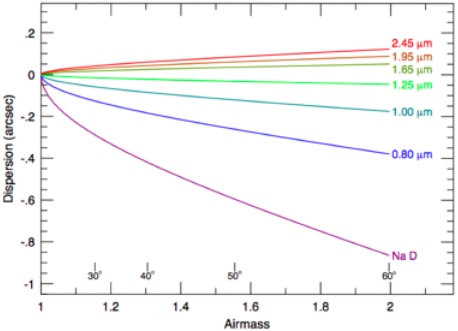 |
| Above: Atmospheric dispersion that occurs for six different wavelengths over varying airmasses. IRIS's ADC will be able to correct for these observed dispersions over the entire near-infared wavelength range (0.85 - 2.5 μm). |
IRIS Science
Project Scientist: Shelley Wright (UCSD)
The combination of a large collecting area and unprecedented angular resolution will have a direct impact on a broad range of science programs that span topics as diverse as the search for extrasolar planets to studies of the first stars to illuminate the Universe. The science team has generated a plethora of astronomical topics that IRIS will be capable of exploring.
Summary of Science Cases
First Light: Identification and characterization of first light galaxies and population III stars. Figure on the right is a simulation of a forming galaxy at z=12.5 and the expected hydrogen number density (Johnson, Greif, Bromm 2008). The dense gas (orange-white) just left of the center of the galaxy represents the formation of two Pop III stars. Overlaid on the figure is a 1″x3″ field of view (3.6kpc x 10.8kpc), which is close to the FOV using IRIS's 0.025″ slicer scale. |
 |
 |
High-z Galaxy Dynamics and Morphologies: Studying galaxy formation and mass assembly over cosmic time (1 < z <5). Using optical emission lines (e.g., Hα, Hβ, [OIII]) to map 2D dynamics of galaxies during the peak epoch of star formation and AGN accretion. The anticipated S/N ratios for Hα emission from four high-z galaxies as observed using the IRIS IFS 0.05″ spatial sampling (see Law et al. 2006). |
Metallicity Evolution and Gradients: Tracing metallicity over cosmic time (1 < z <5) using multiple optical emission lines to determine the chemical enrichment history. The IFS will be able to map metallicity gradients over individual high-z galaxies from different galactic components (i.e.,bulge, disk, outflows, and inflows. The figure on the right is a [NII]/Hα ratio map of a z~1.6 galaxy from the Keck AO system, and shows high spatial concentration (yellow) of [NII]/Hα which shows the presence of a weak AGN within this star-forming dominated galaxy (Wright et al. 2009). IRIS will be essential for distinguishing between AGN and star forming emission from different regions of a galaxy. |
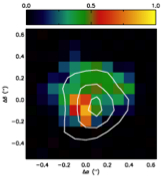 |
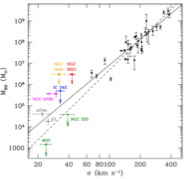 |
Supermassive Black Holes: A study of AGN, black hole demographics and growth throughout cosmic history. The left figure is of the MBH-σ relation plotted for measured black hole masses versus observed dispersions of late-type spirals and nuclear star clusters (Barth et al. 2009). There is a large phase-space regime that requires both higher sensitivity and angular resolution observations of low mass black holes (106 Msun) and high mass black holes (109 Msun). IRIS's finest scale (0.004″) is very suitable for this study. |
Local Galaxies and Stellar Populations: A study of stellar populations in galaxies from the local group to the Virgo cluster. IRIS with its high-angular resolution and sensitivity will be able to produce near-infrared spectra and images of individual stars in nearby galaxies, and will probe the chemical enrichment and formation histories for a range of Hubble types. A one-degree image of the Virgo cluster (18 Mpc) from HST, with the lenticular galaxy at the center and other spiral galaxies on the outskirts. IRIS will be able to study each of these galaxies to an unprecedented image depth. |
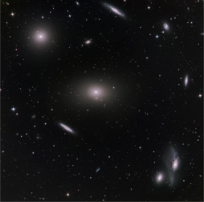 |
 |
Dwarf Galaxies: A study of local dwarf galaxy's dynamical and chemical enrichment to probe the dark matter distribution and differing dark matter models (warm vs. cold). On the left, the cumulative number of Milky Way satellite galaxies as a function of their observed cicular velocities (black points). These observations are compared to the Via Lactea N-body simulation of predicted number of satellites and how differing reionization epochs influences the expected satellite number distribution (Simon & Geha 2007). |
Galactic Center: Studying the properties and conditions surrounding the supermassive black hole (SMBH) at the center of the Galaxy. The relative astrometric accuracy of 30 μas will allow measurements to better constrain MBH, test General Relativity, determine GC distance, and the stellar dynamical history. Right figure is of the current imaging capabilities of the central arcsecond sources from Keck-AO. The image on the right represents the depth and resolution that TMT and IRIS will provide (see UCLA Galactic Center). |
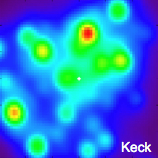 |
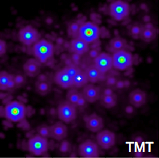 |
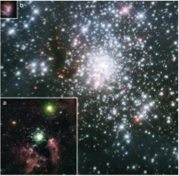 |
Star Formation: Investigating star formation properties in star clusters: timescale of star formation and efficiencies, initial cluster mass funcion (ICMF), initial mass function, multiplicity and kinematics The figure on the left illustrates three clusters with varying masses (30Dor: 105 Msun, NGC3603: 104 Msun, Orion: 103 Msun) which will be resolved with IRIS at distances up to 20 Mpc away. |
Microlensing: Constraining models of stellar structure and evolution by determining precise stellar masses from astrometric microlensing. IRIS, with its high astrometric relative accuracy, will be able to fit mircolens light curves to accurately determine stellar masses for a range of stellar-types. On the right, a proper motion curve for a star over 5 years that has been lensed (solid curve) and without being lens (dashed lens) (Belukurov & Evans 2002). |
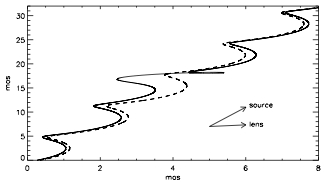 |
 |
Extrasolar Planets: The detection and characterization of extrasolar planets and planet forming environments. On the left, an image of the first extrasolar multiple planet system ever directly-imaged, around the young star HR 8799 (Marois et al. 2008). The image is a near-infrared color composite of J, H, and K bands taken from both Keck and Gemini telescopes using adaptive optics. Each planet is respectively 70, 40, and 25 AU from the central star. A system such as HR 8799 would be easily studied using IRIS. |
Solar System:The formation history of our solar system. Using near-infrared spectroscopy for compositional and dynamical studies of Kuiper Belt Objects (KBO) and transneptunian objects (TNOs). Near infared spectra of Pluto and the TNO, 2005 FY9, show strong methane absorption in the figure on the right (Licandro et al. 2006). |
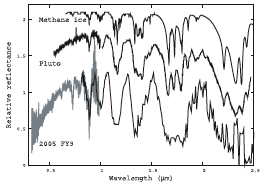 |
Lastly, and perhaps the most intriguing, are the new discoveries that will likely be revealed by IRIS. As is stated in The Exploration of the Unknown by Kellermann el al. 2009, "The excitement of the next generation of astronomical facilities is not in the old questions which will be answered, but in the new questions that they will raise." With IRIS and TMT extending our current technology by orders of magnitude in sensitivity and angular resolution it has the promise of doing just that.
IRIS Team Members
IRIS is a multi-institutional collaboration from USA, Canada, and Japan.
IRIS technical team:
IRIS science team:
